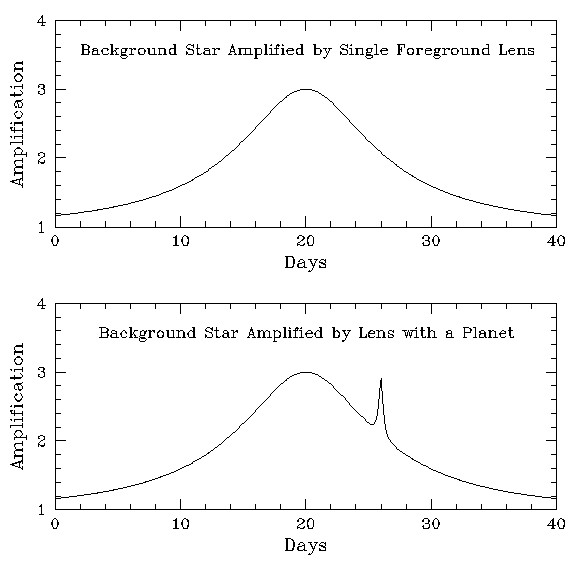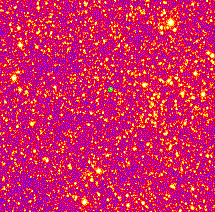

Planetary wiggles in microlensing light curves are caused by the same gravitational effects that create the much more dramatic caustic crossings that can occur in double-star lenses, but are more subtle. The effect will be largest for planets orbiting a few to several AU from their mother lenses. (1 AU = the distance from the Earth to our own Sun.) In our own Solar System, several planets are in these kinds of orbits. The effect will also be larger for larger planets. The smaller the planet, the smaller the defect in the main lensing pattern and so the smaller the chances that the background star will be affected by the planet. Astronomers estimate that several tens of microlensing events will have to be constantly monitored with good precision in order to see the effects of a planet like our own Jupiter, even if every distant lens has a Jupiter orbiting it. These are the planets that the PLANET collaboration is most likely to find with its current strategy. (Planets found by the radial velocity technique, like that around the star 51 Peg -- the first confirmed extra-solar planet discovered -- are much closer to their mother suns and so probably have a different history from our own Jupiter.) Several hundreds of microlensing events must be monitored with even higher precision before Earth-mass planets could be expected to be detected with microlensing; this may become possible in the next few years, but is currently out of reach.
 Because the effects of extra-solar planets on microlensing light curves
can be subtle, care must be taken in the analysis of the data to ensure
that other effects, like atmospheric distortions from turbulent
atmosphere above the telescope or stray moonlight, do not cause
wiggles in the light curve that could mimic a planet. The PLANET
collaboration has developed a technique to remove some of these
troublesome effects. This is particularly important to do in
stellar fields that are as crowded as those that are being
studied near the center the Milky Way (see right), where in poor
conditions light from neighboring stars can be confused with
that from the background lensed star.
Because the effects of extra-solar planets on microlensing light curves
can be subtle, care must be taken in the analysis of the data to ensure
that other effects, like atmospheric distortions from turbulent
atmosphere above the telescope or stray moonlight, do not cause
wiggles in the light curve that could mimic a planet. The PLANET
collaboration has developed a technique to remove some of these
troublesome effects. This is particularly important to do in
stellar fields that are as crowded as those that are being
studied near the center the Milky Way (see right), where in poor
conditions light from neighboring stars can be confused with
that from the background lensed star.
Preliminary analysis of one very precisely monitored light curve by PLANET has shown that the mother lens does not have a Jupiter-mass planet at some positions. The lensing event is called OGLE-98-BLG-14 because it was the 14th event in the direction of the central Bulge of our Galaxy to be announced by the OGLE team in 1998. After taking care to eliminate spurious effects due to atmospheric turbulence, no planetary anomalies were seen by the PLANET collaboration of the sort expected for planets with the mass of Jupiter (or heavier) currently in or near the lensing zone, that is, at distances where planets are found in our Solar System. PLANET results on the absence of massive planets at certain radii around the OGLE-98-BLG-14 lens were first presented at a recent meeting in the United States, and the final analysis is now available. Many more systems like this must be studied before we can know whether or not the distribution of planets in our Solar System is unique.